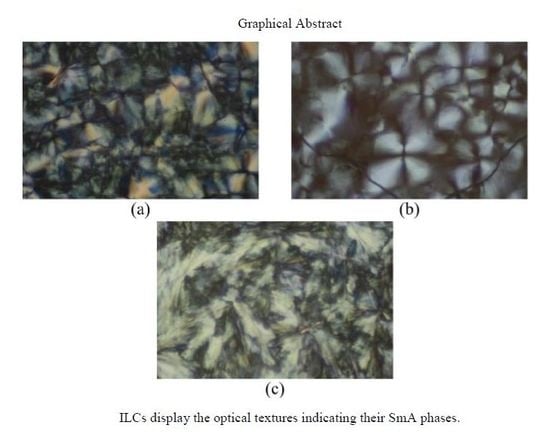Thermotropic Liquid-Crystalline and Light-Emitting Properties of Bis(4-aalkoxyphenyl) Viologen Bis(triflimide) Salts
Abstract
1. Introduction
2. Results and Discussion
2.1. Synthesis of Bis(4-n-alkoxyphenyl)-4,4′-bipyridinium Bis(triflimide) Salts (EV1, EV6, EV8, EV10, EV12, EV14, EV16, EV18, and EV20)
2.2. Thermotropic LC Properties of EVn by DSC, POM, and VT-XRD
2.3. Thermal Stabilities of Extended Viologen Bis(triflimide) Salts (EVn)
2.4. Light Emission Properties of EVCl6 and EV6
3. Materials and Methods
3.1. Instrumentation
3.2. Materials
3.3. Synthesis of 4-n-Alkoxyanilines (n = 6, 8, 10, 12, 14, 16, 18, 20)
3.4. Synthesis of Zincke Salt
3.5. General Procedure for the Synthesis of Bis(4-alkoxyphenyl)-4,4′-Bipyridinium Dichloride (EV1Cl, EV6Cl, EV8Cl, EV10Cl, EV12Cl, EV14Cl, EV16Cl, EV18Cl, and EV20Cl)
3.6. Synthesis of bis(4-Methoxyphenyl)-4,4′-Bipyridinium Bis(triflimide) Salt (EV1)
3.7. General Procedure for the Synthesis of Bis(4-n-alkoxyphenyl)-4,4′-bipyridinium Bis(triflimide) Salts (EV6, EV8, EV10, EV12, EV14, EV16, EV18, EV20) by Metathesis Reaction
4. Conclusions
Supplementary Materials
Author Contributions
Funding
Acknowledgments
Conflicts of Interest
References
- Kato, T.; Yoshio, M. Liquid crystalline ionic liquids. In Electrochemical Aspects of Ionic Liquids; Ohno, H., Ed.; Wiley: New York, NY, USA, 2005; Chapter 25. [Google Scholar]
- Binnemans, K. Ionic Liquid Crystals. Chem. Rev. 2005, 105, 4148–4204. [Google Scholar] [CrossRef] [PubMed]
- Axenov, K.; Laschat, S. Thermotropic ionic liquid crystals. Materials 2011, 4, 206–259. [Google Scholar] [CrossRef] [PubMed]
- Causin, V.; Saielli, G. Ionic liquid crystals. In Green Solvents II. Properties and Applications of Ionic Liquids; Mohammad, A., Inamuddin, D., Eds.; Springer: London, UK, 2012; pp. 79–118. [Google Scholar]
- Mansueto, M.; Laschat, S. Ionic Liquid Crystals. In Handbook of Liquid Crystals. Vol. 6: Nanostructured and Amphiphilic Liquid Crystals, 2nd ed.; Goodby, J.W., Collings, P.J., Kato, T., Tschierske, C., Gleeson, H., Raynes, P., Eds.; Wiley-VCH: Weinheim, Germany, 2014; pp. 231–280. [Google Scholar]
- Fernandez, A.A.; Kouwer, P.H.J. Key Developments in Ionic Liquid Crystals. Int. J. Mol. Sci. 2016, 17, 731. [Google Scholar] [CrossRef] [PubMed]
- Goossens, K.; Lava, K.; Bielawski, C.W.; Binnemans, K. Ionic Liquid Crystals: Versatile Materials. Chem. Rev. 2016, 116, 4643–4807. [Google Scholar] [CrossRef] [PubMed]
- Kato, T.; Yoshio, M.; Ichikawa, T.; Soberats, B.; Ohno, H.; Funahashi, M. Transport of ions and electrons in nanostructured liquid crystals. Nat. Rev. Mater. 2017, 2, 17001. [Google Scholar] [CrossRef]
- Cîrcu, V. Ionic Liquid Crystals Based on Pyridinium Salts. In Progress and Developments in Ionic Liquids; Handy, S., Ed.; INTECH: London, UK, 2017; pp. 285–311. [Google Scholar]
- Devaki, S.J.; Sasi, R. Ionic Lquids/Ionic Liquid Crystals for Safe and Sustainable Energy Storage Systems. In Progress and Developments in Ionic Liquids; Handy, S., Ed.; INTECH: London, UK, 2017; pp. 316–336. [Google Scholar]
- Pastor, M.J.; Sánchez, I.; Campo, J.A.; Schmidt, R.; Cano, M. New pyrazolium salts as a support for ionic liquid crystals and ionic conductors. Materials 2018, 11, 548. [Google Scholar] [CrossRef]
- Yuan, F.; Chi, S.; Dong, S.; Zou, X.; Lv, S.; Bao, L.; Wang, J. Ionic liquid crystals with fast ion-conductive tunnels for potential application in solvent-free Li-ion batteries. Electrochimica Acta 2019, 294, 249–259. [Google Scholar] [CrossRef]
- Ichikawa, T.; Kato, T.; Ohno, H. Dimension control of ionic liquids. Chem. Commun. 2019, 55, 8205–8214. [Google Scholar] [CrossRef]
- Martinetto, Y.; Pégot, B.; Roch-Marchal, C.; Cottyn-Boitte, B.; Floquet, S. Designing functional polyoxometalate-based ionic liquid crystals and ionic liquids. Eur. J. Inorg. Chem. 2020, 2020, 228–247. [Google Scholar] [CrossRef]
- Do, D.T.; Schmitzer, A.R. Intramolecular Diels Alder reactions in highly organized imidazolium salt-based ionic liquid crystals. RSC Adv. 2015, 5, 635–639. [Google Scholar] [CrossRef]
- Do, D.T.; Schmitzer, A.R. Highly ordered rectangular columnar ionic liquid crystals: Medium for intramolecular Diels Alder reactions. ChemistrySelect 2016, 1, 2448–2453. [Google Scholar] [CrossRef]
- Bruce, D.W.; Gao, Y.; Canongia Lopez, J.N.; Shimizu, K.; Slattery, J.M. Liquid-crystalline ionic liquids as ordered reaction media for the Diels-Alder reaction. Chem. Eur. J. 2016, 22, 16113–16123. [Google Scholar] [CrossRef] [PubMed]
- Trilla, M.; Pleixats, R.; Parella, T.; Blanc, C.; Dieudonné, P.; Guari, Y.; Man, M.W.C. Ionic liquid crystals based on mesitylene-containing bis- and trisimidazolium salts. Langmuir 2008, 24, 259–265. [Google Scholar] [CrossRef] [PubMed]
- Tanabe, K.; Suzui, Y.; Hasegawa, M.; Kato, T. Full-color tunable photoluminescent ionic liquid crystals based on tripodal pyridinium, pyrimidinium, and quinolinium salts. J. Am. Chem. Soc. 2012, 134, 5652–5661. [Google Scholar] [CrossRef] [PubMed]
- Asaftei, S.; Ciobanu, M.; Lepadatu, A.M.; Song, E.; Beginn, U. Thermotropic ionic liquid crystals by molecular assembly and ion pairing of 4,4′-bipyridinium derivatives and tris(dodecyloxy)benzenesulfonates in a non-polar solvent. J. Mater. Chem. 2012, 22, 14426–14437. [Google Scholar] [CrossRef]
- Robertson, L.A.; Schenkel, M.R.; Wiesenauer, B.R.; Gin, D.L. Alkyl-bis(imidazolium) salts: A new amphiphile platform that forms thermotropic and non-aqueous lyotropic bicontinuous cubic phases. Chem. Commun. 2013, 49, 9407–9409. [Google Scholar] [CrossRef]
- Schenkel, M.R.; Shao, R.; Robertson, L.A.; Wiesenauer, B.R.; Clark, N.A.; Gin, D.L. New ionic organic compounds containing a linear tris(imidazolium) core and their thermotropic liquid crystal behavior. Liq. Cryst. 2013, 40, 1067–1081. [Google Scholar] [CrossRef]
- Schenkel, M.R.; Hooper, J.B.; Moran, M.J.; Robertson, L.A.; Bedrov, D.; Gin, D.L. Effect of counter-ion on the thermotropic liquid crystal behaviour of bis(alkyl)-tris(imidazolium salt) compounds. . Liq. Cryst. 2014, 41, 1668–1685. [Google Scholar] [CrossRef]
- Yang, M.; Stappert, K.; Mudring, A.-V. Bis-cationic ionic liquid crystals. J. Mater. Chem. C 2014, 2, 458–473. [Google Scholar] [CrossRef]
- D’Anna, F.; Noto, R. Di- and tricationic organic salts: An overview of their properties and applications. Eur. J. Org. Chem. 2014, 2014, 4201–4223. [Google Scholar]
- Casella, G.; Causin, V.; Rastrelli, F.; Saielli, G. Viologen-based ionic liquid crystals: Induction of a smectic A phase by dimerization. Phys. Chem. Chem. Phys. 2014, 16, 5048–5051. [Google Scholar] [CrossRef] [PubMed]
- Casella, G.; Causin, V.; Rastrelli, F.; Saielli, G. Ionic liquid crystals based on viologen dimers: Tuning the mesophormism by varying the conformational freedom of the ionic layer. Liq. Cryst. 2016, 43, 1161–1173. [Google Scholar] [CrossRef]
- Bhowmik, P.K.; Chang, A.; Kim, J.; Dizon, E.J.; Principe, R.C.G.; Han, H. Thermotropic liquid-crystalline properties of viologen containing 4-n-alkylbenzenesulfonates. Crystals 2019, 9, 77. [Google Scholar] [CrossRef]
- Chae, H.; Lee, Y.-H.; Yang, M.; Yoon, W.-J.; Yoon, D.K.; Jeong, K.-U.; Song, Y.H.; Choi, U.H.; Lee, M. Interesting phase behaviors and ion-conducting properties of dicationic N-alkylimidazolium tetrafluoroborate salts. RSC Adv. 2019, 9, 3972–3978. [Google Scholar] [CrossRef]
- Song, Y.; Tang, X.; Kong, S.; Bai, L.; He, X.; Meng, F. Synthesis and characterization of hexamethylenetetramine-based ionic liquid crystals. J. Mol. Struc. 2019, 1178, 135–141. [Google Scholar] [CrossRef]
- Bhowmik, P.K.; Han, H.; Cebe, J.J.; Burchett, R.A.; Acharya, A.; Kumar, S. Ambient temperature thermotropic liquid crystalline viologen bis(triflimide) salts. Liq. Cryst. 2003, 30, 1433–1440. [Google Scholar] [CrossRef]
- Bhowmik, P.K.; Han, H.; Nedeltchev, I.K.; Cebe, J.J. Room-temperature thermotropic ionic liquid crystals: Viologen bis(triflimide) salts. Mol. Cryst. Liq. Cryst. 2004, 419, 27–46. [Google Scholar] [CrossRef]
- Bhowmik, P.K.; Killarney, S.T.; Li, J.R.A.; Koh, J.J.; Han, H.; Sharpnack, L.; Agra-Kooijman, D.M.; Fisch, M.R.; Kumar, S. Thermotropic liquid-crystalline properties of extended viologen bis(triflimide) salts. Liq. Cryst. 2018, 45, 872–885. [Google Scholar] [CrossRef]
- Causin, V.; Saielli, G. Effect of asymmetric substitution on the mesomorphic behaviour of low-melting viologen salts of bis(trifluoromethanesulfonyl)amide. J. Mater. Chem. 2009, 19, 9153–9162. [Google Scholar] [CrossRef]
- Haramoto, Y.; Yin, M.; Matukawa, Y.; Ujiie, S.; Nanasawa, M. A new ionic liquid crystal compound with viologen group in the principal structure. Liq. Cryst. 1995, 19, 319–320. [Google Scholar] [CrossRef]
- Wang, R.-T.; Lee, G.-H.; Lai, C.K. Anion-induced ionic liquid crystals of diphenylviologens. J. Mater. Chem. 2018, 6, 9430–9444. [Google Scholar] [CrossRef]
- Veltri, L.; Cavallo, G.; Beneduci, A.; Metrangolo, P.; Corrente, G.A.; Ursini, M.; Romeo, R.; Terraneo, G.; Gabriele, B. Synthesis and thermotropic properties of new green electrochromic ion liquid crystals. New J. Chem. 2019, 43, 18285–18293. [Google Scholar] [CrossRef]
- Goossens, K.; Lava, K.; Nockemann, P.; Van Hecke, K.; Van Meervelt, L.; Pattison, P.; Binnemans, K.; Cardinaels, T. Pyrrolidinium ionic liquid crystals with pendant mesogenic groups. Langmuir 2009, 25, 5881–5897. [Google Scholar] [CrossRef] [PubMed]
- Douce, L.; Suisse, J.-M.; Guillon, D.; Taubert, A. Imidazolium-based liquid crystals: A modular platform for versatile new materials with finely tunable properties and behaviour. Liq. Cryst. 2011, 38, 1653–1661. [Google Scholar] [CrossRef]
- Li, T.; Xu, F.; Shi, W. Ionic liquid crystals based on 1-alkyl-3-imidazolium cations and perfluorinated sulfonylimide anions. Chem. Phys. Lett. 2015, 628, 9–15. [Google Scholar] [CrossRef]
- Sudhakar, S.; Narasimhaswamy, T.; Srinivasan, K.S.V. Synthesis, characterization, and thermal properties of 4,4′-bis(4-n-alkoxybenzoyloxy)benzylideneanilines and bis(4-benzylidene-4′-n-alkoxyaniline) terephthalates. Liq. Cryst. 2000, 27, 1525–1532. [Google Scholar] [CrossRef]
- Sharma, G.D.; Saxena, D.; Roy, M.S. Studies on electrical and photoelectrical behaviour of ITO/ArV/In Schottky barrier device. Synth. Met. 1999, 106, 97–105. [Google Scholar] [CrossRef]
- Cheng, W.-C.; Kurth, M.J. The Zincke reaction. A Review. Organic Preparations and Procedures International 2002, 34, 585–608. [Google Scholar] [CrossRef]
- Chen, L.; Willcock, H.; Wedge, C.J.; Hartl, F.; Colquhoun, H.M.; Greenland, B.W. Efficient access to conjugated 4,4′-bipyridinium oligomers using the Zincke reaction: Synthesis, spectroscopic and electrochemical properties. Org. Biomol. Chem. 2016, 14, 980–988. [Google Scholar] [CrossRef]
- Gray, G.W.; Goodby, J.W.G. Smectic Liquid Crystals: Textures and Structures; Leonard Hill: Glasgow, UK, 1984. [Google Scholar]
- Collins, P.J.; Hird, M. Introduction to Liquid Crystals Chemistry and Physics; Taylor & Francis: Bristol, PA, USA, 1997. [Google Scholar]
- Demus, D.; Goodby, J.W.; Gray, G.W.; Speiss, H.-W.; Vill, V. (Eds.) Handbook of Liquid Crystals; Wiley-VCH: Weinheim, Germany, 1998; Volume 1–3. [Google Scholar]
- Dierking, I. Textures of Liquid Crystals; Wiley-VCH: Weinheim, Germany, 2003. [Google Scholar]
- Goodby, J.W.; Collings, P.J.; Kato, T.; Tschierske, C.; Gleeson, H.F.; Raynes, P. (Eds.) Handbook of Liquid Crystals: 8 Volumes Set, 2nd ed.; Wiley-VCH: Weinheim, Germany, 2014. [Google Scholar]
- Holbrey, J.D.; Seddon, K.R. The phase behaviour of 1-alkyl-3-methylimidazolium tetrafluoroborates; ionic liquids and ionic liquid crystals. J. Chem. Soc. Dalton Trans. 1999, 13, 2133–2139. [Google Scholar] [CrossRef]
- Bradley, A.E.; Hardacre, C.; Holbrey, J.D.; Johnston, S.; McMath, S.E.J.; Nieuwenhuyzen, M. Small-angle X-ray scattering studies of liquid crystalline 1-alkyl-3-methylimidazolium salts. Chem. Mater. 2002, 14, 629–635. [Google Scholar] [CrossRef]
- Kouwer, P.H.J.; Swager, T.M. Synthesis and mesomorphic properties of rigid-core ionic liquid crystals. J. Am. Chem. Soc. 2007, 129, 14042–14052. [Google Scholar] [CrossRef]
- Wang, X.; Heinemann, F.W.; Yang, M.; Melcher, B.U.; Fekete, M.; Mudring, A.-V.; Wasserscheid, P.; Meyer, K. A new class of double alkyl-substituted, liquid crystalline imidazolium ionic liquids—a unique combination of structural features, viscosity effects, and thermal properties. Chem. Commun. 2009, 47, 7405–7407. [Google Scholar] [CrossRef] [PubMed]
- Yang, M.; Mallik, B.; Mudring, A.-V. On the mesophase formation of 1,3-dialkylimidazolium ionic liquids. Cryst. Growth Des. 2013, 13, 3068–3077. [Google Scholar] [CrossRef]
- Rohini, R.; Lee, C.-K.; Lu, J.-T.; Lin, I.J.B. Symmetrical 1,3-dialkylimidazolium based on ionic liquid crystals. J. Chin. Chem. Soc. 2013, 60, 745–754. [Google Scholar] [CrossRef]
- Wang, X.; Sternberg, M.; Kohler, F.T.U.; Melcher, B.U.; Wasserscheid, P.; Meyer, K. Long-alkyl-chain-derivatized imidazolium salts and ionic liquid crystals with tailor-made properties. RSC Adv. 2014, 4, 12476–12481. [Google Scholar] [CrossRef]
- Stappert, K.; Ünal, D.; Spielberg, E.T.; Mudring, A.-V. Influence of the counteranion on the ability of 1-dodecyl-3-methyltriazolium ionic liquids to form mesophases. Cryst. Growth Des. 2015, 15, 752–758. [Google Scholar] [CrossRef]
- Golding, J.; Forsyth, S.; MacFarlane, D.R.; Forsyth, M.; Deacon, G.B. Methanesulfonate and p-toluenesulfonate salts of the N-methyl-N-alkylpyrrolidinium and quaternary ammonium cations: Novel low cost ionic liquids. Green Chem. 2002, 4, 223–229. [Google Scholar] [CrossRef]
- De Roche, J.; Gordon, C.M.; Imrie, C.T.; Ingram, M.D.; Kennedy, A.R.; Lo Celso, F.; Triolo, A. Application of complementary experimental techniques to characterization of the phase behavior of [C16mim][PF6] and [C14mim][PF6]. Chem. Mater. 2003, 15, 3089–3097. [Google Scholar] [CrossRef]
- Bhowmik, P.K.; Han, H.; Nedeltchev, I.K.; Cebe, J.J.; Kang, S.W.; Kumar, S. Synthesis and characterization of ionic liquids: Viologen bis{tetrakis[3,5-bis(trifluoromethyl)phenyl]borate} salts. Liq. Cryst. 2006, 33, 891–906. [Google Scholar] [CrossRef]
- Jo, T.J.; McCurdy, W.L.; Tanthmanatham, O.; Kim, T.K.; Han, H.; Bhowmik, P.K.; Heinrich, B.; Donnio, B. Synthesis and characterization of luminescent tricationic salts of mesitylene and stilbazolium moieties. J. Mol. Struc. 2012, 1019, 174–182. [Google Scholar] [CrossRef]
- Bhowmik, P.K.; Lee, C.I.; Koh, J.J.; Han, H.; Jubair, A.; Kartazaev, V.; Gayen, S.K. Synthesis, optical, and thermal properties of 2,4,6-tris(4-substituted phenyl)pyrylium tosylates and triflimides. J. Mol. Struc. 2020, 1202, 127325. [Google Scholar] [CrossRef]
- Ji, Y.; Shi, R.; Wang, Y.; Saielli, G. Effect of the chain length on the structure of ionic liquids: From spatial heterogeneity to ionic liquid crystals. J. Phys. Chem. B 2013, 117, 1104–1109. [Google Scholar] [CrossRef] [PubMed]
- Saielli, G.; Voth, G.A.; Wang, Y. Diffusion mechanisms in smectic ionic liquid crystals: Insights from coarse-grained MD simulations. Soft Matter 2013, 9, 5716–5725. [Google Scholar] [CrossRef]
- Saielli, G. Comparison of the ionic liquid crystal phase of [C12C1im][BF4] and [C12C1im]Cl by atomistic MD simulations. Crystals 2020, 10, 253. [Google Scholar] [CrossRef]
- Dutronc, T.; Terazzi, E.; Guénée, L.; Buchwalder, K.-L.; Floquet, S.; Piguet, C. Chemical programming of the domain of existence of liquid crystals. Chem. - Eur. J. 2016, 22, 1385–1391. [Google Scholar] [CrossRef]
- Nelyubina, Y.V.; Shaplov, A.S.; Lozinskaya, E.I.; Buzin, M.I.; Vygodskii, Y.S. A new volume-based approach for predicting thermophysical behavior of ionic liquids and ionic liquid crystals. J. Am. Chem. Soc. 2016, 138, 10076–10079. [Google Scholar] [CrossRef]
- Xu, F.; Matsumoto, K.; Hagiwara, R. Effect of alkyl chain length on properties of 1-alkyl-3-methylimidazolium fluorohydrogenate ionic liquid crystals. Chem. - Eur. J. 2010, 16, 12970–12976. [Google Scholar] [CrossRef]
- Stappert, K.; Lipinski, G.; Kopiec, G.; Spielberg, E.T. Mesophase stabilization in ionic liquid crystals through pairing equally shaped mesogenic cations and anions. Cryst. Growth Des. 2015, 15, 5388–5396. [Google Scholar] [CrossRef]
- Nedeltchev, A.K.; Han, H.; Bhowmik, P.K. Design and synthesis of photoactive ionic amorphous molecular materials. J. Mater. Chem. 2011, 21, 12717–12724. [Google Scholar] [CrossRef]
- Jo, T.S.; Nedeltchev, A.K.; Biswas, B.; Han, H.; Bhowmik, P.K. Synthesis and characterization of poly(pyridinium salt)s derived from various diamines. Polymer 2012, 53, 1063–1071. [Google Scholar] [CrossRef]
- Jo, T.S.; Koh, J.J.; Han, H.; Bhowmik, P.K. Solution, thermal and optical properties of bis(pyridinium salt)s ionic liquids. Mater. Chem. Phys. 2013, 139, 901–910. [Google Scholar] [CrossRef]
Sample Availability: Samples of the compounds are not available from the authors. |
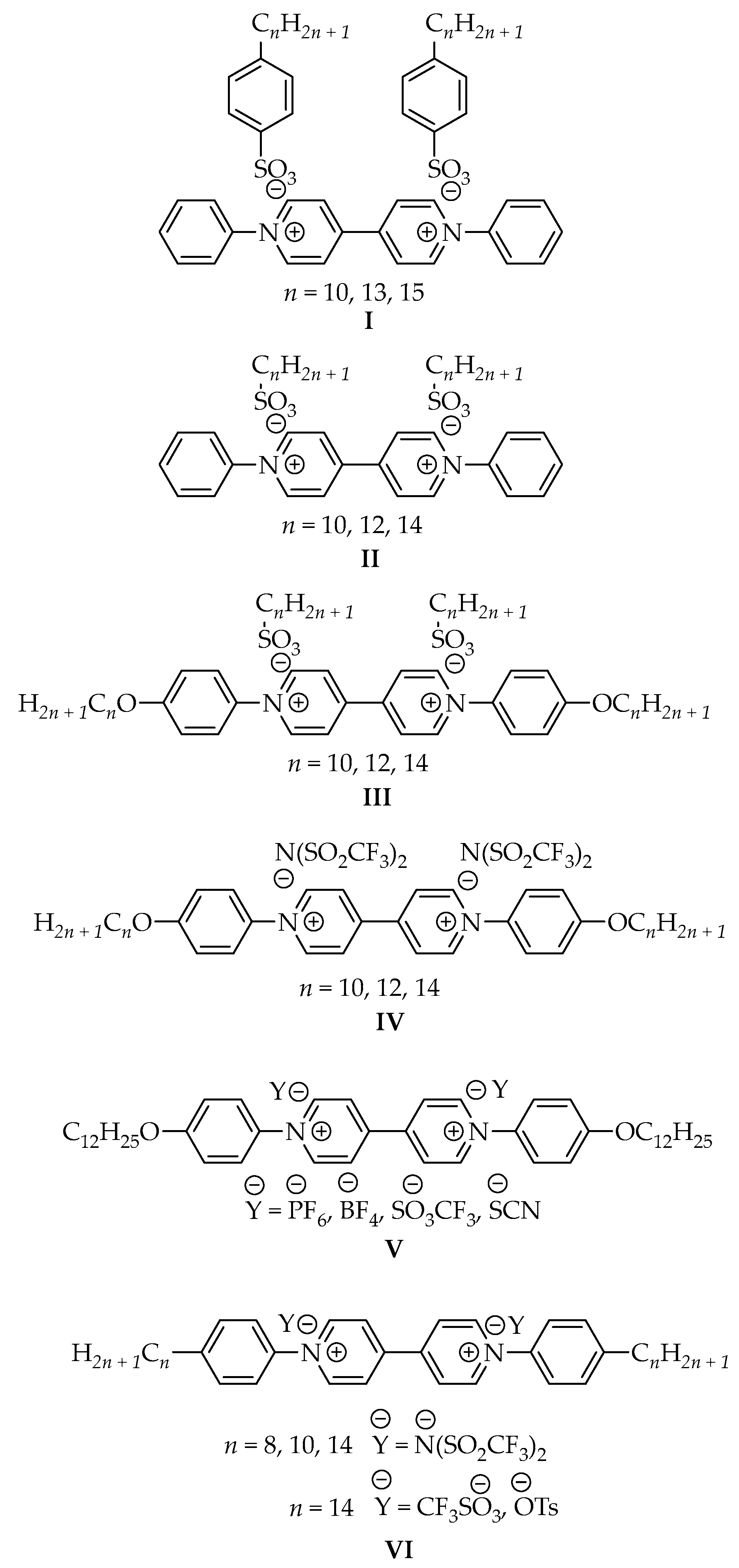
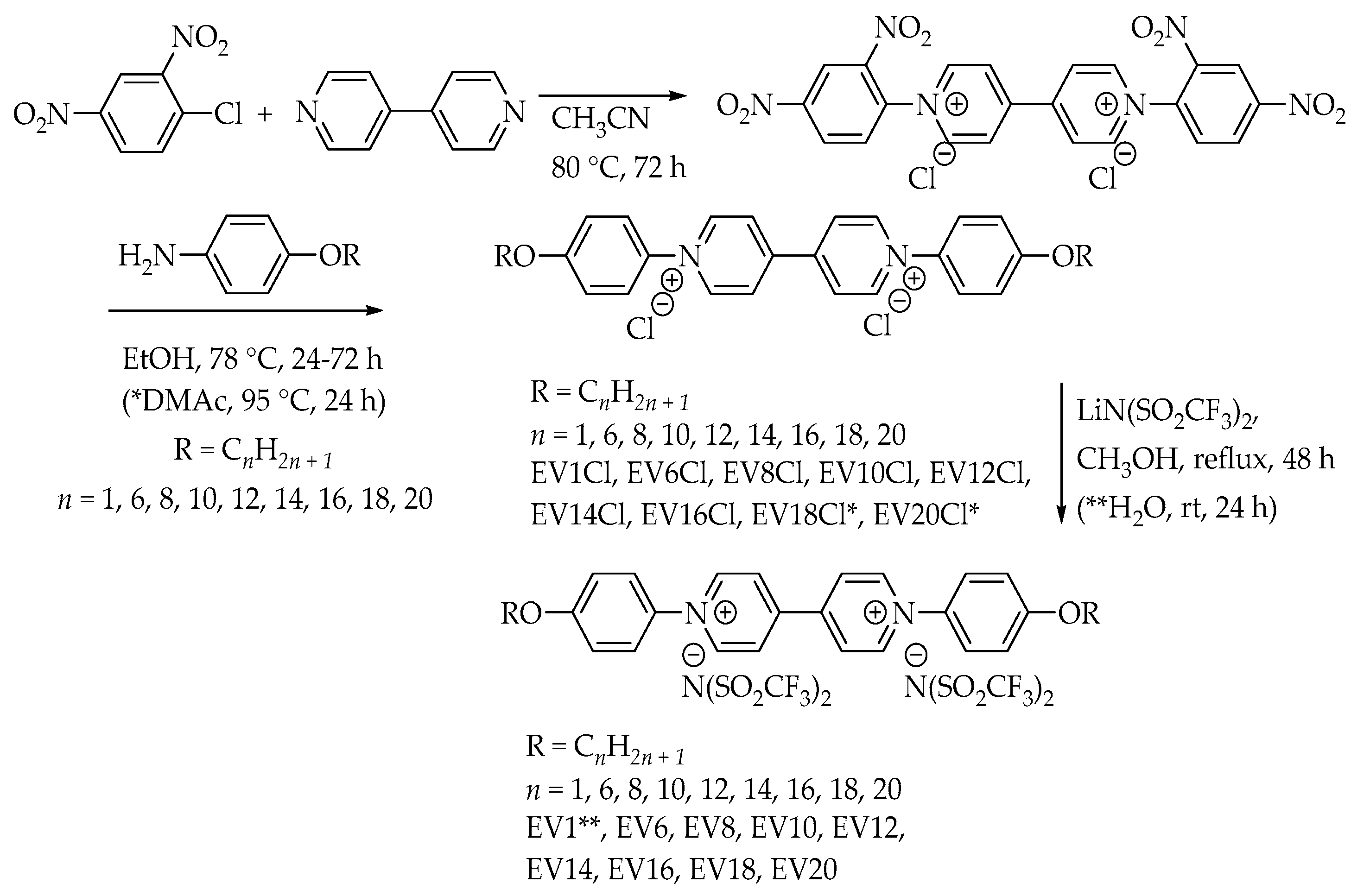

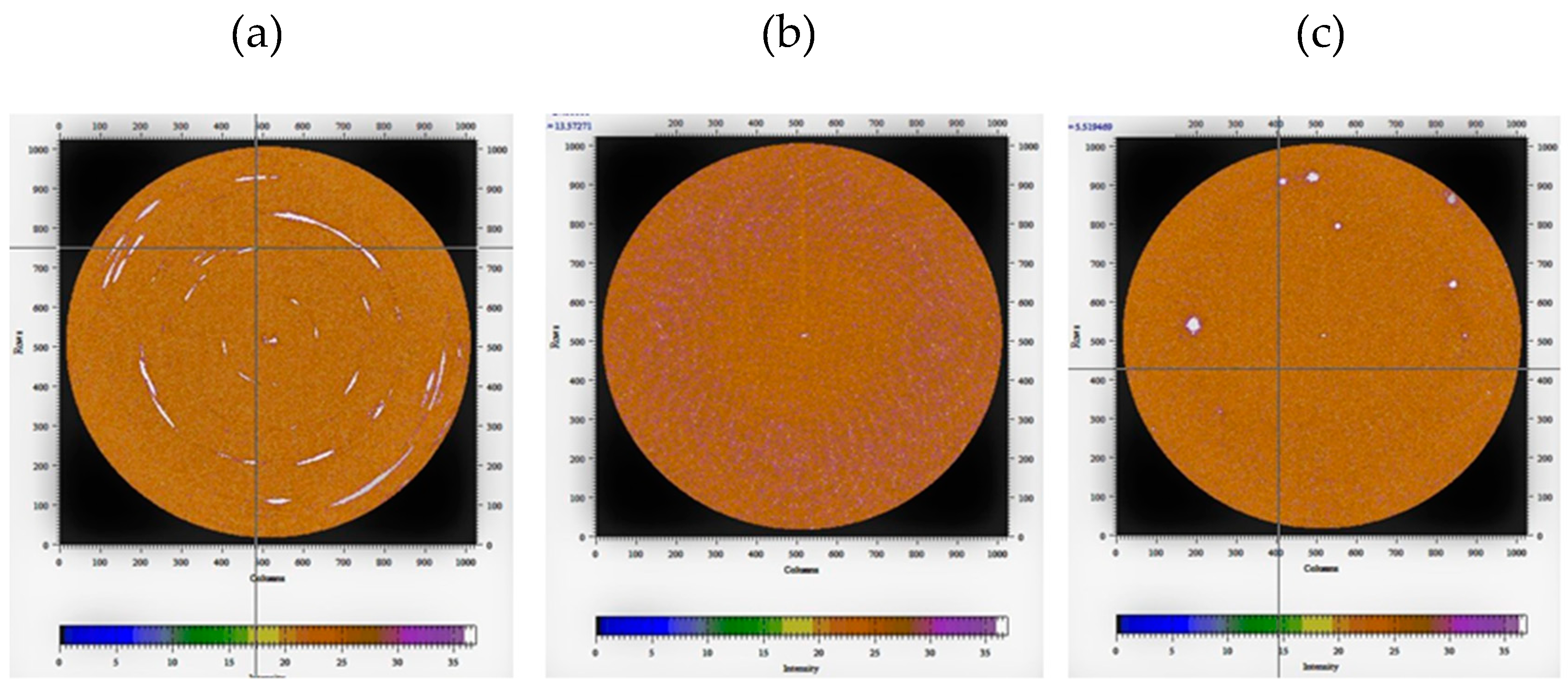
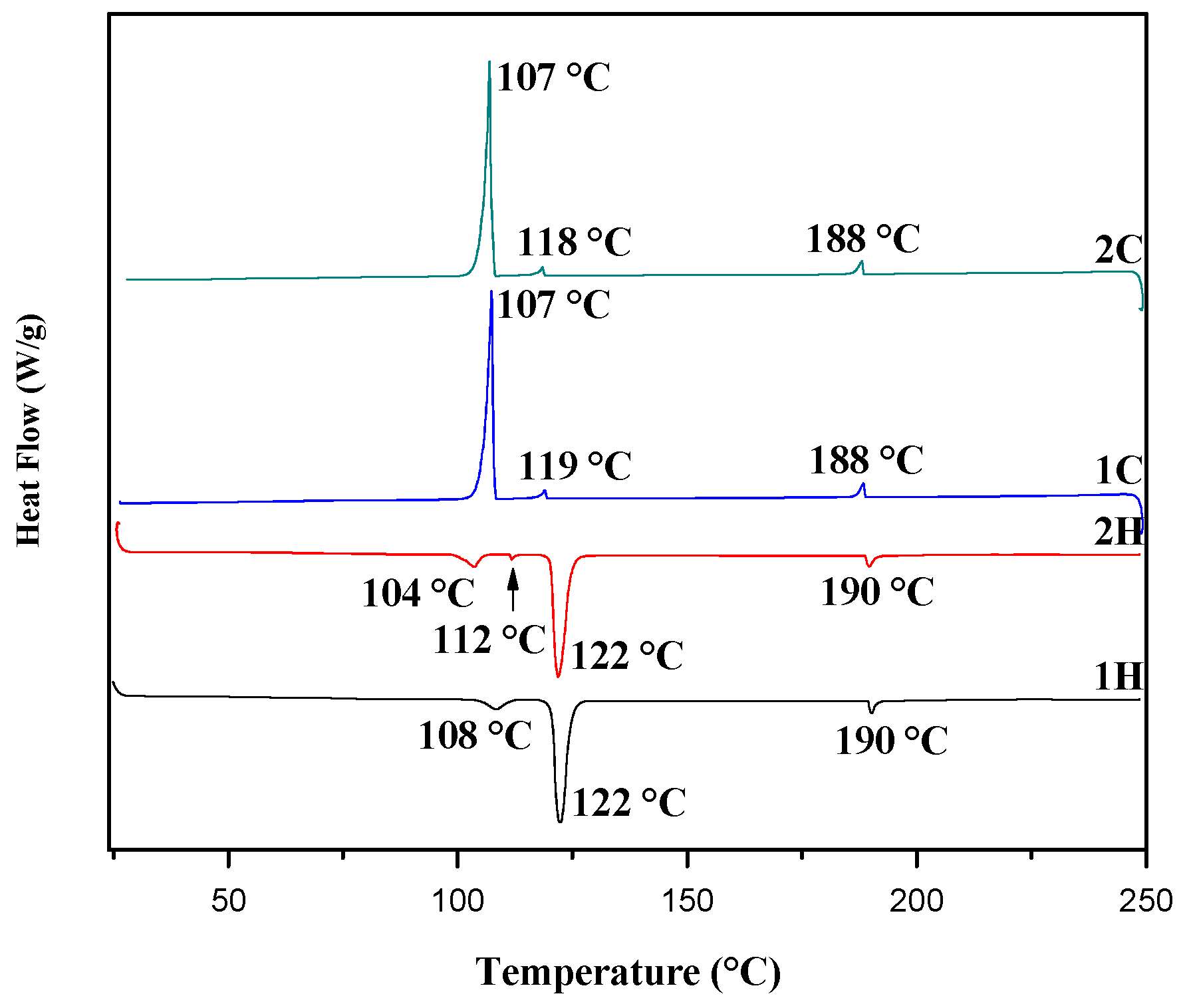
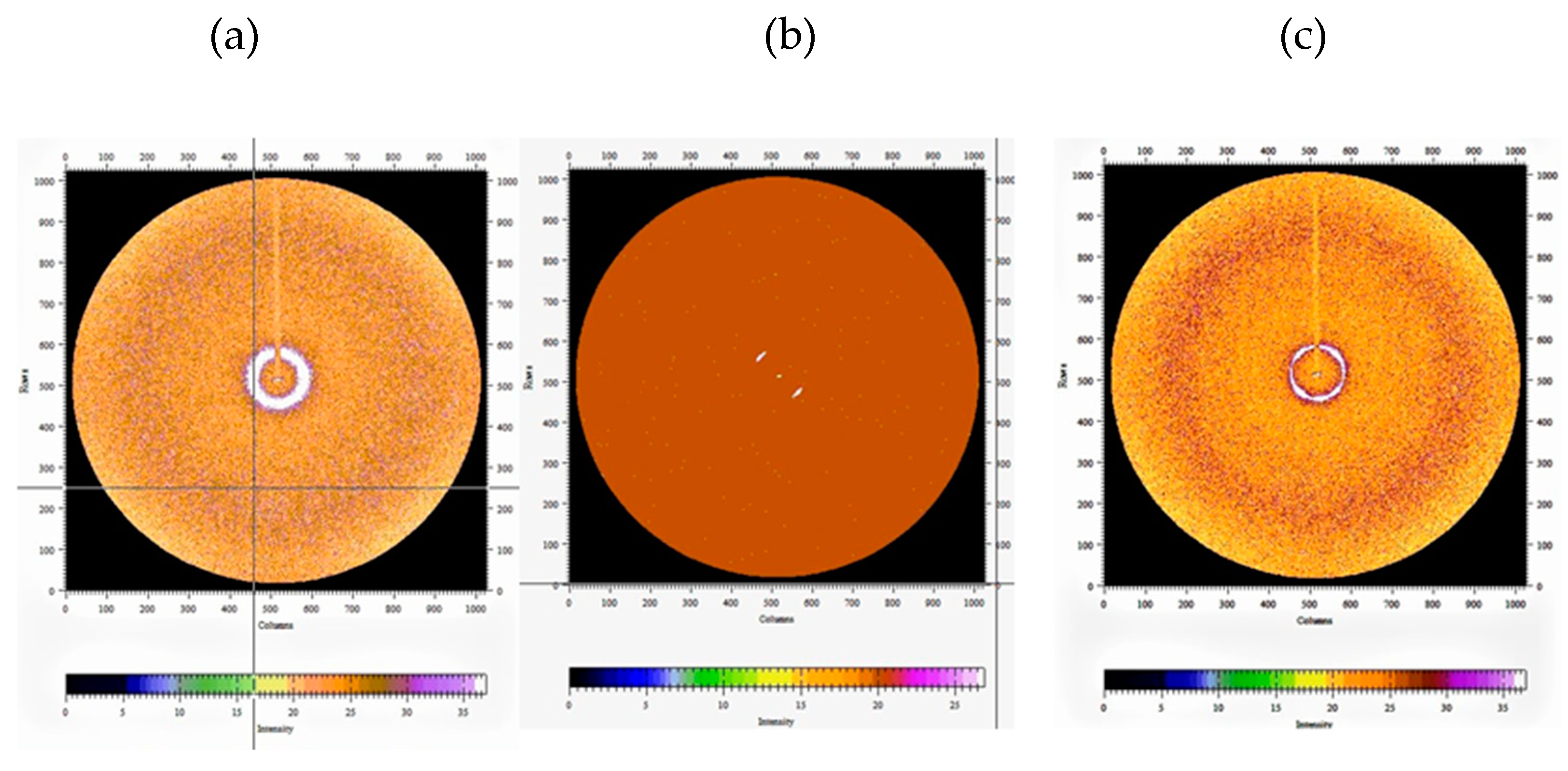
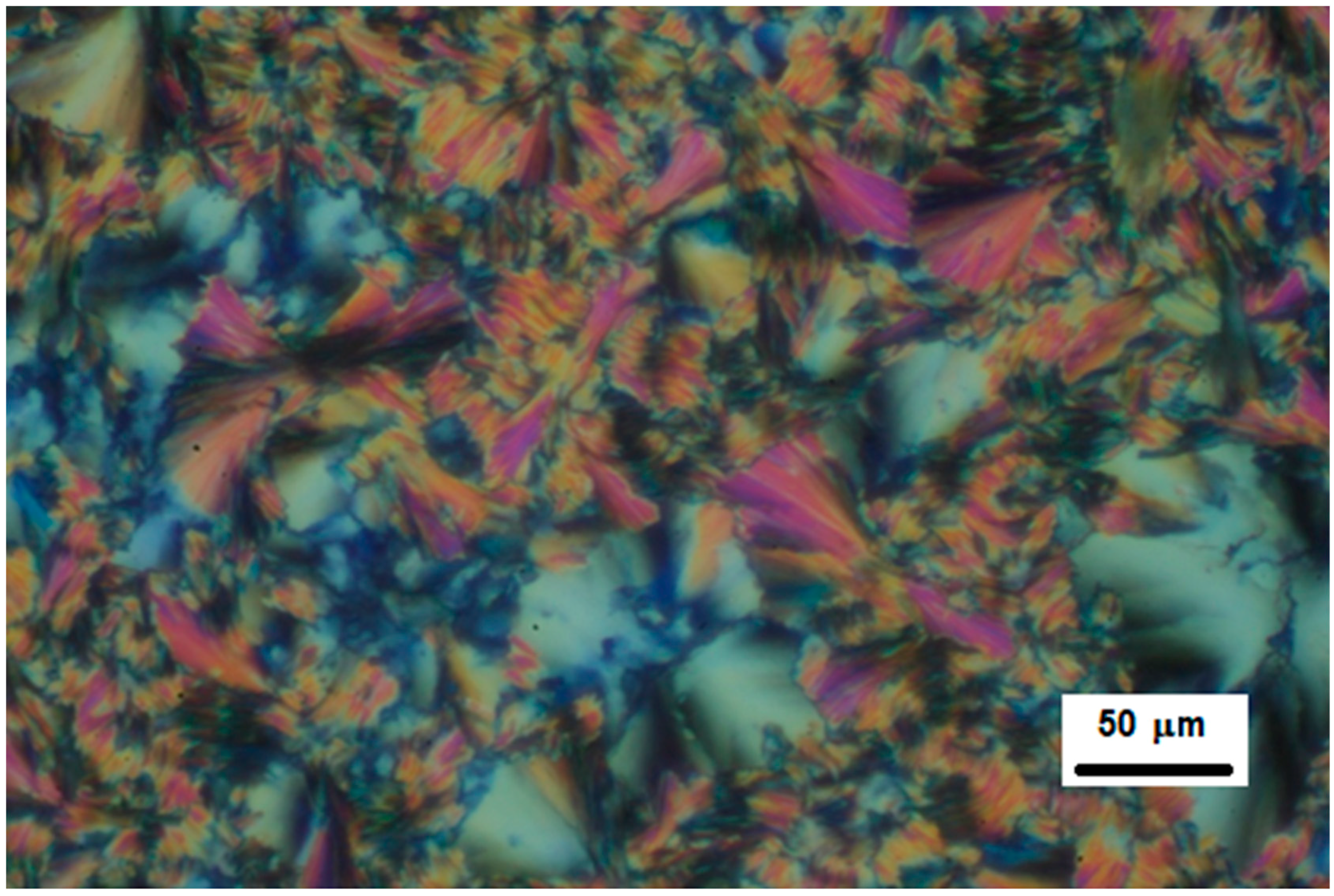
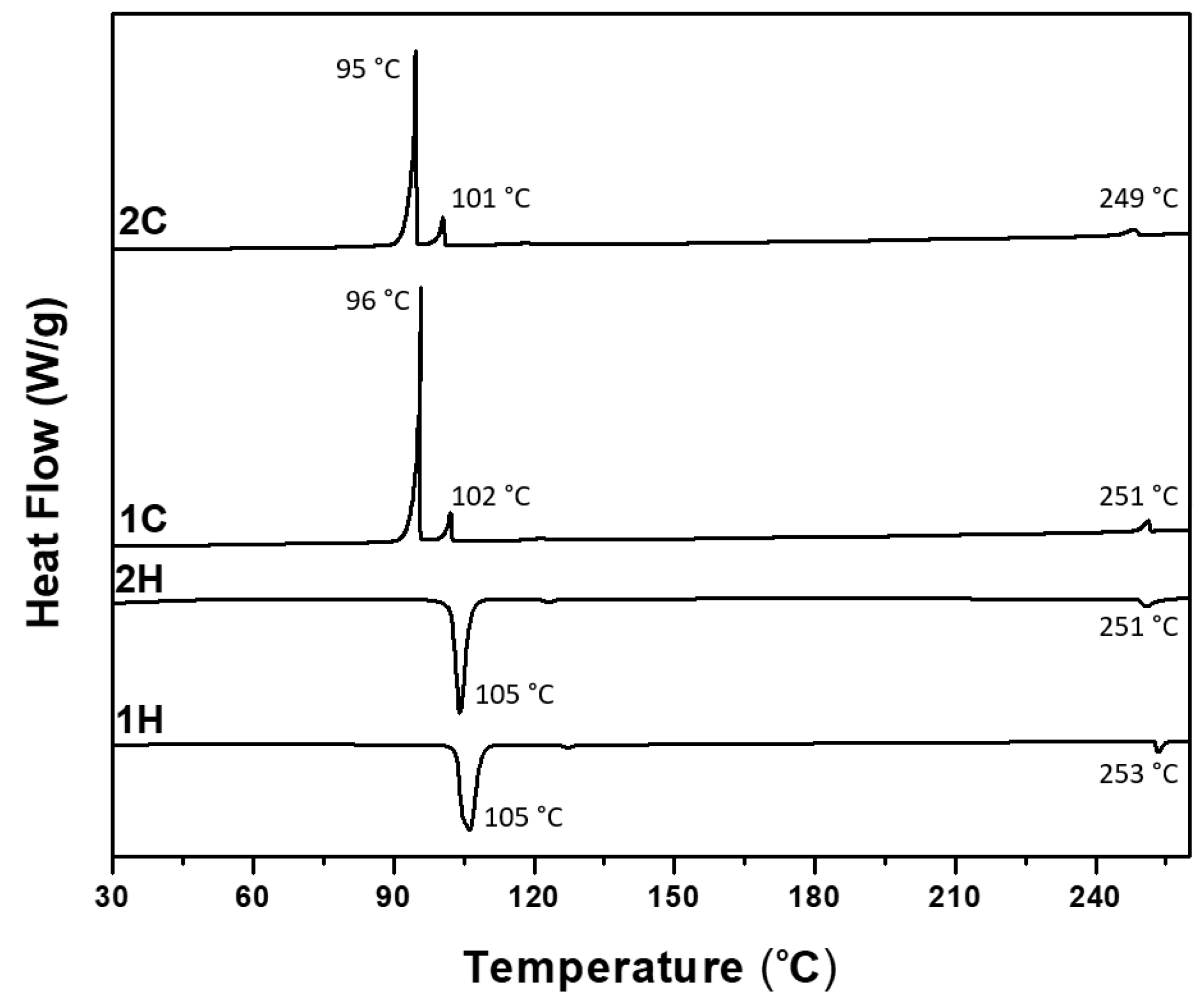
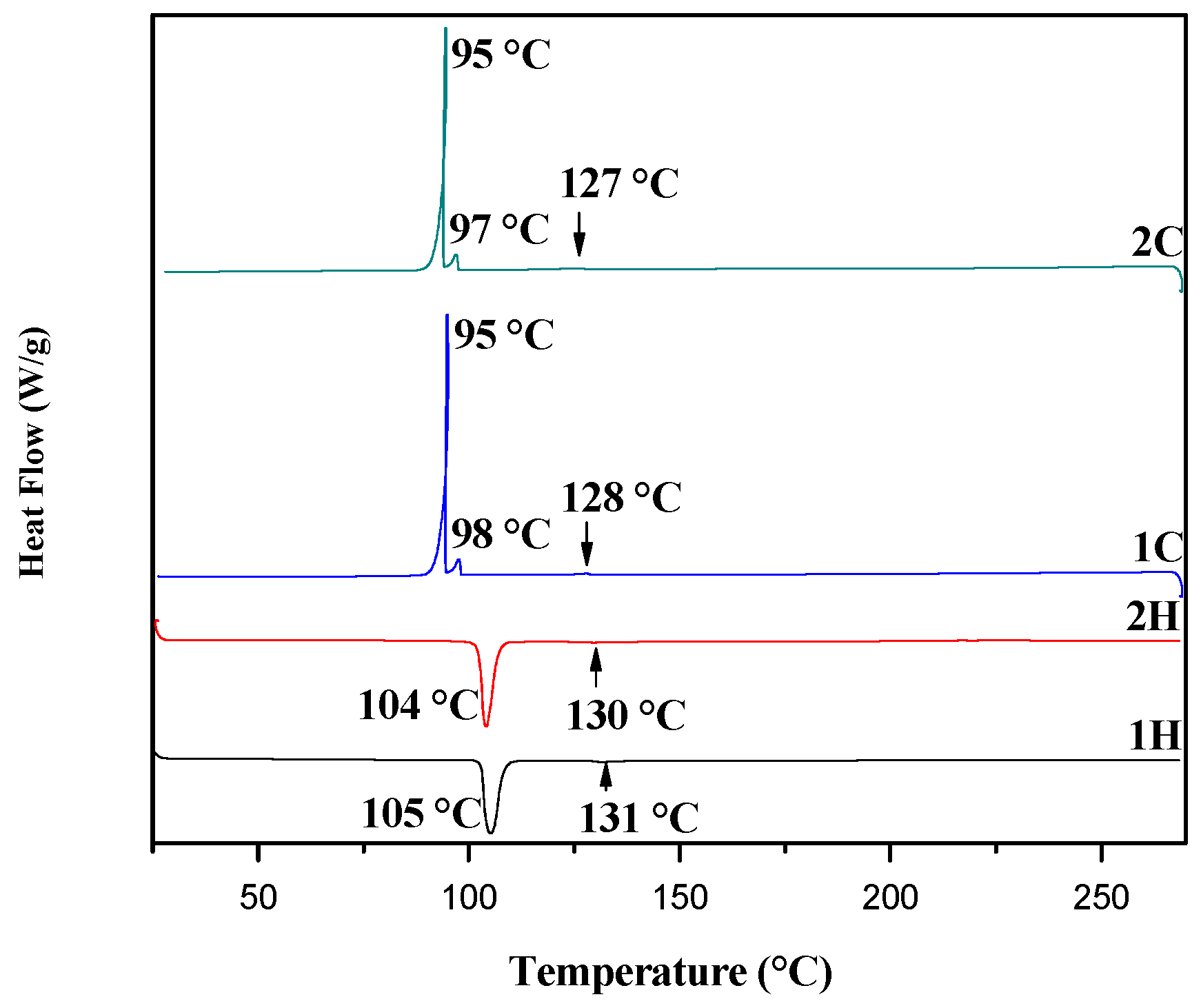
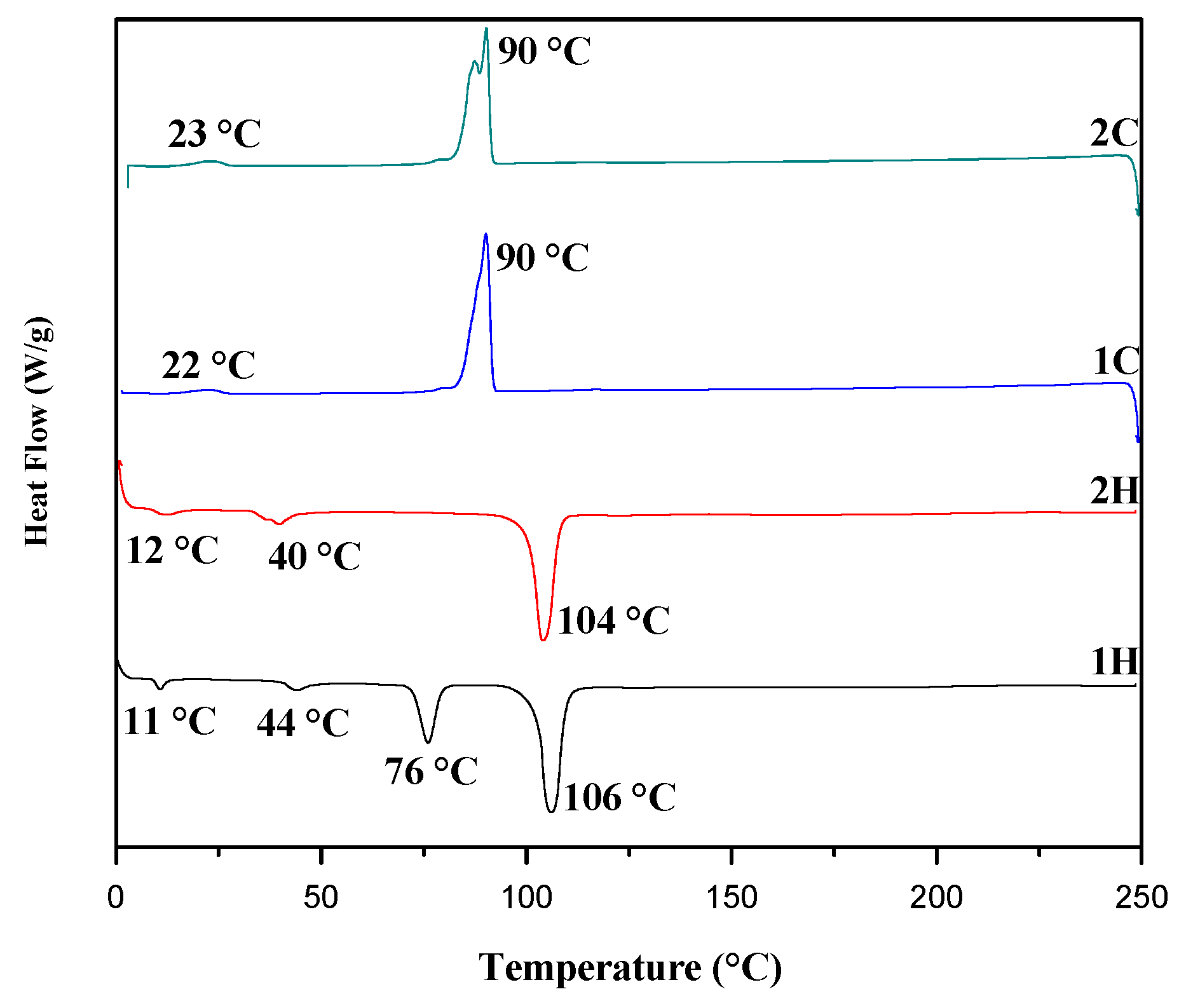
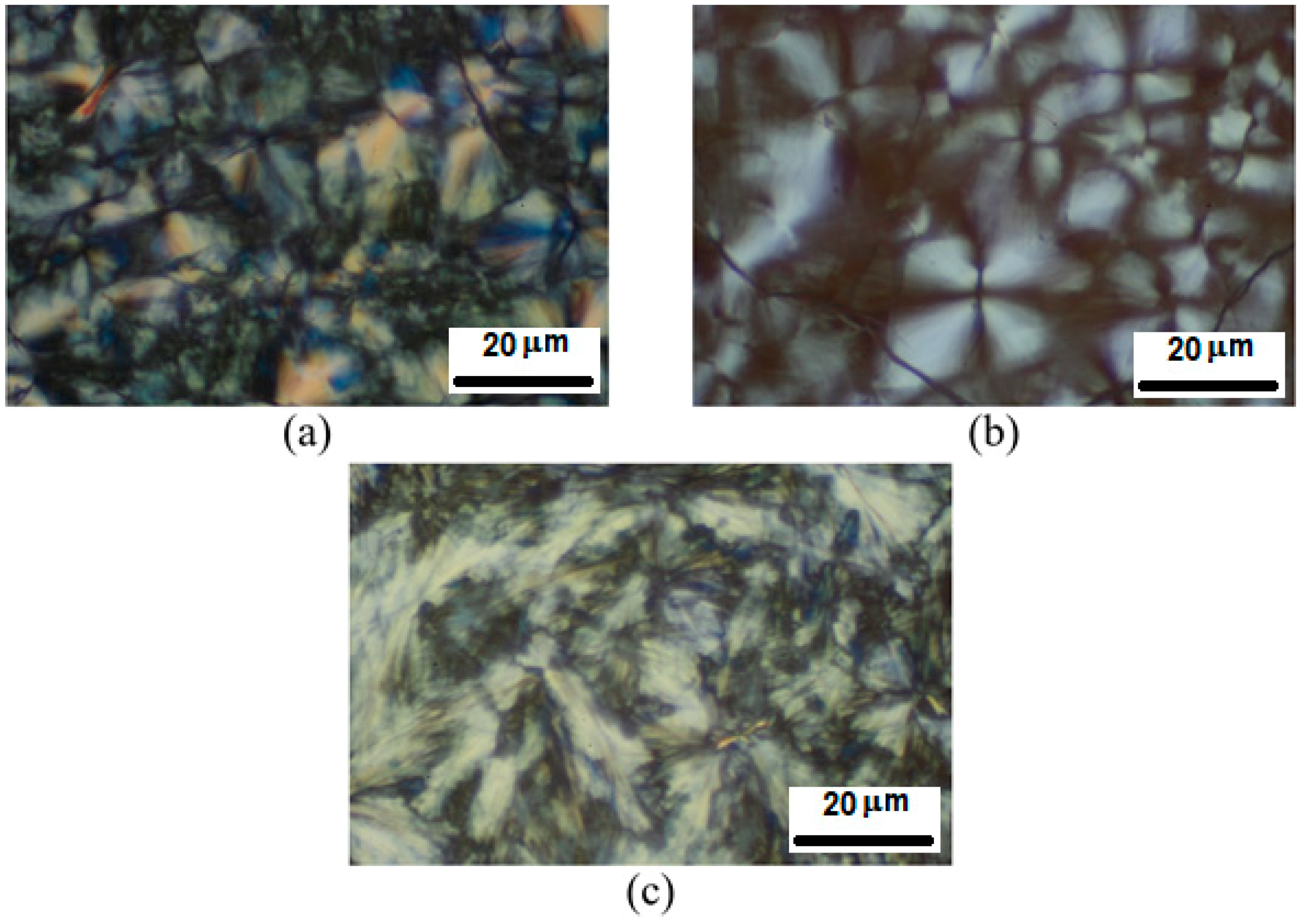
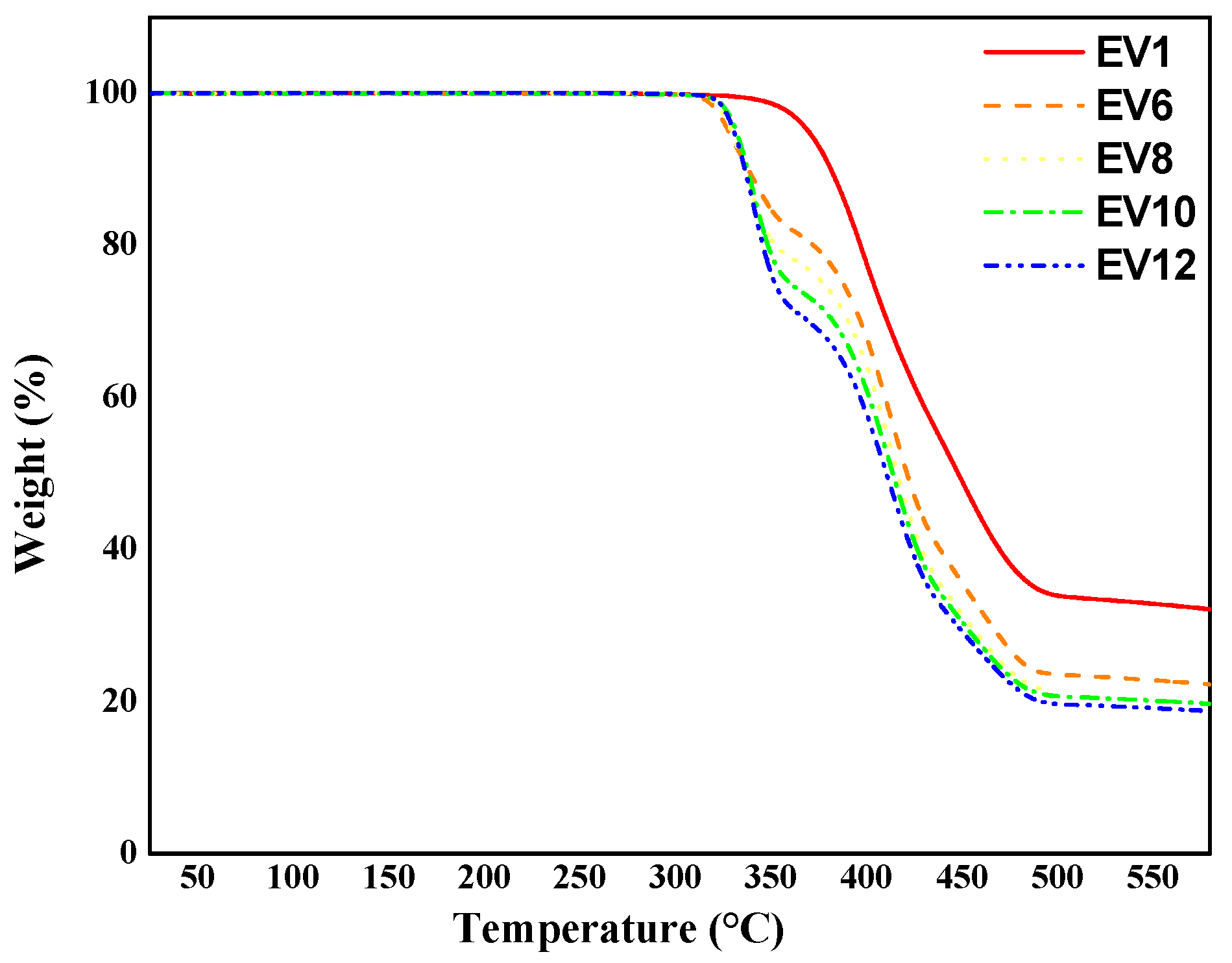

| Sample | Tm a °C | Tm b °C | TLC-LC c °C | Ti d °C | ΔT e °C | Td f °C |
|---|---|---|---|---|---|---|
| EV1 | 104 g (17.4), 164 (25.8) | - | - | - | - | 370 |
| EV6 | 75 g (0.84), 105 (38.2) | - | - | - | - | 328 |
| EV8 | - | 104 g (4.6), 112 g (0.36), 122 (43.5) | - | 190 (1.8) | 68 | 330 |
| EV10 | - | 104 (46.1) | 123 (0.6) | 251 (2.3) | 147 | 332 |
| EV12 | - | 104 (56.8) | 130 (0.3) | 305 h (3.4) | - | 331 |
| EV14 | - | 12 g (2.1), 40 g (5.5), 104 (55.9) | - | 328 h | - | 337 |
| EV16 | - | 54 g (1.0), 82 g (3.3), 101 (49.2) | - | - | - | 337 |
| EV18 | - | 63 g (2.4), 70 g (6.2), 106 (69.6) | - | - | - | 331 |
| EV20 | - | 71 g (2.9), 83 g (4.5), 107 (71.8) | - | - | - | 330 |
© 2020 by the authors. Licensee MDPI, Basel, Switzerland. This article is an open access article distributed under the terms and conditions of the Creative Commons Attribution (CC BY) license (http://creativecommons.org/licenses/by/4.0/).
Share and Cite
Bhowmik, P.K.; Al-Karawi, M.K.M.; Killarney, S.T.; Dizon, E.J.; Chang, A.; Kim, J.; Chen, S.L.; Principe, R.C.G.; Ho, A.; Han, H.; et al. Thermotropic Liquid-Crystalline and Light-Emitting Properties of Bis(4-aalkoxyphenyl) Viologen Bis(triflimide) Salts. Molecules 2020, 25, 2435. https://doi.org/10.3390/molecules25102435
Bhowmik PK, Al-Karawi MKM, Killarney ST, Dizon EJ, Chang A, Kim J, Chen SL, Principe RCG, Ho A, Han H, et al. Thermotropic Liquid-Crystalline and Light-Emitting Properties of Bis(4-aalkoxyphenyl) Viologen Bis(triflimide) Salts. Molecules. 2020; 25(10):2435. https://doi.org/10.3390/molecules25102435
Chicago/Turabian StyleBhowmik, Pradip K., Muhammed Kareem M. Al-Karawi, Shane T. Killarney, Erenz J. Dizon, Anthony Chang, Jongin Kim, Si L. Chen, Ronald Carlo G. Principe, Andy Ho, Haesook Han, and et al. 2020. "Thermotropic Liquid-Crystalline and Light-Emitting Properties of Bis(4-aalkoxyphenyl) Viologen Bis(triflimide) Salts" Molecules 25, no. 10: 2435. https://doi.org/10.3390/molecules25102435
APA StyleBhowmik, P. K., Al-Karawi, M. K. M., Killarney, S. T., Dizon, E. J., Chang, A., Kim, J., Chen, S. L., Principe, R. C. G., Ho, A., Han, H., Mandal, H. D., Cortez, R. G., Gutierrez, B., Mendez, K., Sharpnack, L., Agra-Kooijman, D. M., Fisch, M. R., & Kumar, S. (2020). Thermotropic Liquid-Crystalline and Light-Emitting Properties of Bis(4-aalkoxyphenyl) Viologen Bis(triflimide) Salts. Molecules, 25(10), 2435. https://doi.org/10.3390/molecules25102435






